Herschel finds first evidence of Earth-like water in a comet
5 October 2011
A team of astronomers using ESA's Herschel Space Observatory have discovered the first comet containing water that is similar in isotopic composition to that in Earth's oceans. This detection, in the comet 103P/Hartley 2, shows that contrary to earlier belief, comets may well have played an important role in bringing water to our planet, and that the reservoir of Earth-like water in the Solar System is far larger than suspected.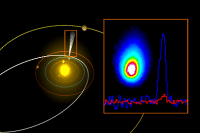 |
| Herschel image and spectrum of comet 103P/Hartley 2 and its orbit. Credit: ESA/AOES Medialab; Herschel/HssO Consortium |
Today, over 70 per cent of the Earth's surface is covered in water. In our planet's early days, however, its surface was so hot that it caused water and other volatiles to evaporate. Researchers agree that the water currently present on Earth has been delivered at a later stage during the planet's evolution, most likely by comets and asteroids. The relative contribution of each class of object to our planet's water supply is, however, still debated.
Shedding light on the nature of the main water carriers to Earth would improve our current understanding of the Solar System's formation and dynamical evolution. The role of comets in this context is particularly intriguing, since these bodies may have contributed to enriching our planet not only with water, but also with the carbon- and nitrogen-based compounds that are of great importance to the emergence of life.
To investigate further, astronomers seek the signature of water in the spectra of comets and asteroids. But how can they link it to the origin of this fundamental molecule on Earth? A good diagnostic to compare water found in different celestial bodies is to analyse the relative abundance of molecules made up of different isotopes. Depending on its isotopic composition, water appears in various 'flavours', technically known as isotopologues; among these are 'ordinary' water (H216O), composed of two hydrogen (H) and one oxygen (16O) atoms, and semi-heavy water (HDO), where one of the hydrogen atoms appears in its isotopical form of deuterium (D, or 2H).
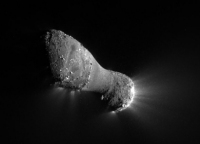 |
| Close-up of comet 103P/Hartley 2 taken by NASA's EPOXI mission. Credit: NASA, JPL-Caltech, UMD, EPOXI Mission |
In the Earth's oceans, the deuterium-to-hydrogen ratio (D/H) has been determined to be 1.56×10-4. This value is similar to that measured in some meteorites found on Earth, which are believed to originate from the outer asteroid belt. In contrast, all of the six comets for which this ratio had been measured so far, including the well-known Halley and Hale-Bopp comets, show a value about twice as high as that of Earth-like water. These data seemed to suggest that asteroids, rather than comets, are the primary agents that delivered water to our planet.
A new study, based on Herschel observations using the HIFI instrument, has brought comets back on the scene, thus reopening the debate about the origin of water on Earth. The data demonstrate that comet 103P/Hartley 2, which was discovered in 1986, harbours water that has a D/H ratio similar to that of Earth's oceans. This comet has appeared in our skies on four more occasions since; the last time in late 2010, during which it was observed with Herschel.
"This is the first measurement of the D/H ratio of a Jupiter-Family comet," notes Paul Hartogh from the Max-Planck-Institut für Sonnensystemforschung (MPS) in Katlenburg-Lindau, Germany. Hartogh is the first author of a paper to appear in the journal Nature and published online on 5 October 2011. "The previous six determinations of this ratio focussed exclusively on Oort-Cloud comets," he adds.
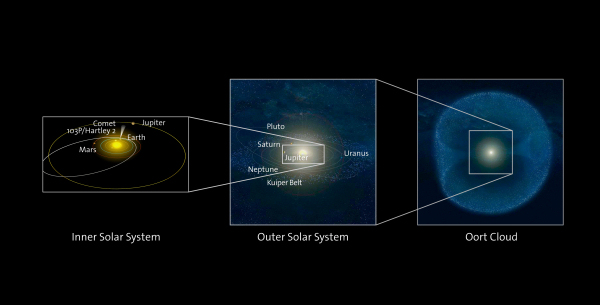 |
| The location of Jupiter-Family comet 103P/Hartley 2, the Kuiper Belt and the Oort Cloud in the Solar System. Credit: ESA/AOES Medialab |
Jupiter-Family (JF) and Oort-Cloud (OC) comets differ in their orbits as well as orbital periods, and have very distinct birthplaces. JF comets, with periods of a few years and aphelia close to the orbits of Jupiter and the other giant planets, are thought to have formed in the Kuiper Belt, at the outskirts of the Solar System, and to have migrated inwards only later. OC comets have most likely undergone the opposite process. With periods of 200 years or more, these comets are believed to have originated in the vicinity of the giant planets and to have been ejected later, via gravitational interactions, to the Oort Cloud, well beyond the outer Solar System.
Comets harbour material from the pristine cloud from which the planets formed about 4500 million years ago, making them unique tools with which to probe the early Solar System. In fact, these wandering fossils reflect the primordial composition of their respective places of origin: the Kuiper Belt in the case of JF comets, and the region where the giant planets formed, in the case of OC comets.
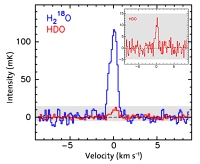 |
| Water signatures in Herschel/HIFI spectrum of comet 103P/Hartley 2. Image courtesy of Paul Hartogh |
The recent approach of comet 103P/Hartley 2 to Earth was the closest since its discovery, offering an extraordinary opportunity to measure chemical abundances in a JF comet. "We took advantage of such a rare chance and used Herschel to obtain exquisite spectra of this comet," says Hartogh. The astronomers were able to detect the spectral signature of two different isotopologues of water: HDO and H218O, the latter being a proxy for 'ordinary' water (H216O). "The HDO feature is about 10 times weaker than the other one and it would have been very hard to single out had the comet not been so close to the observatory," explains Hartogh. These observations led to the first estimate of the D/H ratio in a JF comet.
"The D/H ratio of water in comets is a cosmic equivalent of forensic 'chemical fingerprinting': by measuring it and comparing it to the theoretical values we can, in principle, nail down the comet's birthplace," comments co-author Dariusz Lis from the California Institute of Technology in Pasadena, California. The classical theoretical picture suggests that, in the early Solar System, the D/H ratio in water was rather low in the vicinity of the Sun and increasingly larger with increasing heliocentric distance. Given that JF comets supposedly formed farther away from the Sun than their OC counterparts, astronomers expected that they would be characterised by a higher value of this ratio. "Instead, 103P/Hartley 2 clearly exhibits a lower D/H ratio, which happens to be very similar to that of the water in Earth's oceans," explains co-author Dominique Bockelée-Morvan from the Laboratoire d'Études Spatiales et d'Instrumentation en Astrophysique (LESIA) of the Observatoire de Paris at Meudon, France.
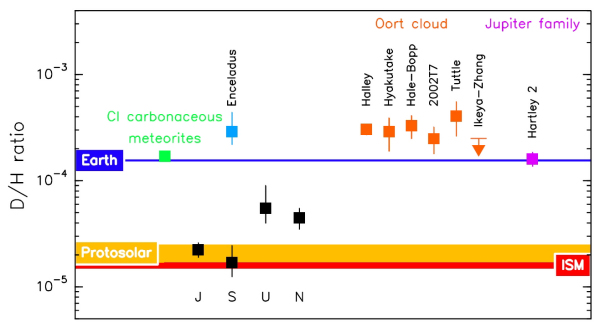 |
| The deuterium-to-hydrogen ratio for various bodies in the Solar System. Image courtesy of Paul Hartogh |
The result indicates that something in the underlying models is not correct. It is possible that JF comets did not originate in the Kuiper Belt. Alternatively, the theoretical framework describing the distribution of deuterium and hydrogen in the early Solar System may be incomplete.
Theoretical implications aside, the study's foremost merit is that it legitimises afresh the role of comets as the carriers of water to our planet. In the light of the new data, the reservoir of Earth-like water in the Solar System appears to be significantly larger than previously thought.
"The unique sensitivity and spectral resolution of the HIFI instrument flown on board Herschel enables us to observe different isotopologues of water in comets," comments Göran Pilbratt, ESA's Herschel Project Scientist. "As this result clearly demonstrates, HIFI observations are shedding new light on the possible origins of water on Earth."
Notes for editors
The study presented here is based on observations performed with Herschel's Heterodyne Instrument for the Far Infrared, HIFI. The observations were carried out as part of the ‘Water and related chemistry in the Solar System' Key Programme.
In October and November 2010, Herschel joined in a global campaign to observe comet 103P/Hartley 2 at several wavelengths across the electromagnetic spectrum, taking advantage of the comet's closest approach to Earth since its discovery. These observations also provided support to NASA's EPOXI mission, which flew past the comet on 4 November 2011.
The D/H ratio of water in comet 103P/Hartley 2 was estimated by comparing the spectral lines of HDO at 509 GHz and H218O at 548 GHz. 'Ordinary' water (H216O) was not probed in the study because, due to its large abundance in the cometary ejecta, its spectral lines are optically thick and only account for a fraction of the total water volume. As a proxy for H216O, astronomers used H218O, which is characterised by optically thin lines just like HDO, and employed the ratio of H218O to H216O, which is well known, to calibrate the results.
According to the Vienna Standard Mean Ocean Water (VSMOW), a standard defining the isotopic composition of water, the value of the D/H ratio in Earth-like water is 1.558 ± 0.001 ×10-4.
Herschel is ESA's infrared space observatory with science instruments provided by European-led Principal Investigator consortia and important participation from NASA.
HIFI, or the Heterodyne Instrument for the Far Infrared, has been designed and built by a consortium of institutes and university departments across Europe, Canada, and the United States under the leadership of SRON Netherlands Institute for Space Research, Groningen, the Netherlands, with major contributions from Germany, France, and the US.
HIFI Consortium members are: Canada: CSA, U. Waterloo; France: CESR, LAB, LERMA, IRAM; Germany: KOSMA, MPIfR, MPS; Ireland: NUI Maynooth; Italy: ASI, IFSI-INAF, Osservatorio Astrofisico di Arcetri-INAF; Netherlands: SRON, TUD; Poland: CAMK, CBK; Spain: Observatorio Astronómico Nacional (IGN), Centro de Astrobiología (CSIC-INTA); Sweden: Chalmers University of Technology - MC2, RSS & GARD, Onsala Space Observatory, Swedish National Space Board, Stockholm University – Stockholm Observatory; Switzerland: ETH Zurich, FHNW; USA: Caltech, JPL, NHSC.
Related publications
P. Hartogh, et al., "Ocean-like water in the Jupiter-family comet 103P/Hartley 2", 2011, Nature, 478, 7368
Contacts
Paul Hartogh
Max-Planck-Institut für Sonnensystemforschung
Katlenburg-Lindau, Germany
Email: hartogh mps.mpg.de
mps.mpg.de
Phone: +49 5556 979342
Dariusz C. Lis
California Institute of Technology
Pasadena, California, USA
E-mail: dcl caltech.edu
caltech.edu
Phone: +1 626 395 6617
Dominique Bockelée-Morvan
LESIA-Observatoire de Paris, CNRS, UPMC, Université Paris-Diderot
Meudon, France
E-mail: Dominique.Bockelee obspm.fr
obspm.fr
Phone: +33 1 45077605
Göran Pilbratt
Herschel Project Scientist
Research and Scientific Support Department
Science and Robotic Exploration Directorate
ESA, The Netherlands
Email: gpilbratt rssd.esa.int
rssd.esa.int
Phone: +31 71 565 3621




